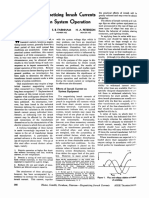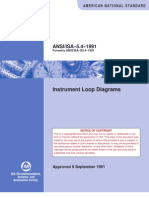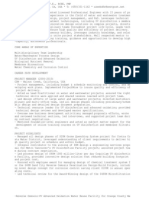Lecture 10: Power-Flow Studies: Instructor: Dr. Gleb V. Tcheslavski Contact: Office Hours
Uploaded by
An00pgadzillaLecture 10: Power-Flow Studies: Instructor: Dr. Gleb V. Tcheslavski Contact: Office Hours
Uploaded by
An00pgadzilla1
Lecture 10: Power-Flow studies
Instructor:
Dr. Gleb V. Tcheslavski
Contact:
gleb@ee.lamar.edu
Office Hours:
TBD; Room 2030
Class web site:
http://www.ee.lamar.edu/
gleb/power/Index.htm
Image from http://top-car-wallpaper.blogspot.com/
0 to 60 mph in 3.9 s; Redline 14,000 rpm; ~250 hp; ~375 Nm,
Base price $109,000
ELEN 3441 Fundamentals of Power Engineering
Spring 2009
Introduction
We should be able to analyze the performance of power systems
both in normal operating conditions and under fault (short-circuit)
condition. The analysis in normal steady-state operation is called a
power-flow study (load-flow study) and it targets on determining
the voltages, currents, and real and reactive power flows in a
system under a given load conditions.
The purpose of power flow studies is to plan ahead and account for
various hypothetical situations. For instance, what if a transmission
line within the power system properly supplying loads must be
taken off line for maintenance. Can the remaining lines in the
system handle the required loads without exceeding their rated
parameters?
ELEN 3441 Fundamentals of Power Engineering
Spring 2009
Basic techniques for power-flow
studies.
A power-flow study (load-flow study) is an analysis of the voltages, currents,
and power flows in a power system under steady-state conditions. In such a study,
we make an assumption about either a voltage at a bus or the power being
supplied to the bus for each bus in the power system and then determine the
magnitude and phase angles of the bus voltages, line currents, etc. that would
result from the assumed combination of voltages and power flows.
The simplest way to perform power-flow calculations is by iteration:
1.Create a bus admittance matrix Ybus for the power system;
2.Make an initial estimate for the voltages at each bus in the system;
3.Update the voltage estimate for each bus (one at a time), based on the
estimates for the voltages and power flows at every other bus and the values of
the bus admittance matrix: since the voltage at a given bus depends on the
voltages at all of the other busses in the system (which are just estimates), the
updated voltage will not be correct. However, it will usually be closer to the answer
than the original guess.
4.Repeat this process to make the voltages at each bus approaching the correct
answers closer and closer
ELEN 3441 Fundamentals of Power Engineering
Spring 2009
Basic techniques for power-flow
studies.
The equations used to update the estimates differ for different types of busses.
Each bus in a power system can be classified to one of three types:
1. Load bus (PQ bus) a buss at which the real and reactive power are specified,
and for which the bus voltage will be calculated. Real and reactive powers supplied
to a power system are defined to be positive, while the powers consumed from the
system are defined to be negative. All busses having no generators are load
busses.
2. Generator bus (PV bus) a bus at which the magnitude of the voltage is kept
constant by adjusting the field current of a synchronous generator on the bus (as
we learned, increasing the field current of the generator increases both the
reactive power supplied by the generator and the terminal voltage of the system).
We assume that the field current is adjusted to maintain a constant terminal
voltage VT. We also know that increasing the prime movers governor set points
increases the power that generator supplies to the power system. Therefore, we
can control and specify the magnitude of the bus voltage and real power supplied.
ELEN 3441 Fundamentals of Power Engineering
Spring 2009
Basic techniques for power-flow
studies.
3. Slack bus (swing bus) a special generator bus serving as the reference bus
for the power system. Its voltage is assumed to be fixed in both magnitude and
phase (for instance, 10 pu). The real and reactive powers are uncontrolled: the
bus supplies whatever real or reactive power is necessary to make the power flows
in the system balance.
In practice, a voltage on a load bus may change with changing loads. Therefore,
load busses have specified values of P and Q, while V varies with load conditions.
Real generators work most efficiently when running at full load. Therefore, it is
desirable to keep all but one (or a few) generators running at 100% capacity, while
allowing the remaining (swing) generator to handle increases and decreases in
load demand. Most busses with generators will supply a fixed amount of power
and the magnitude of their voltages will be maintained constant by field circuits of
generators. These busses have specific values of P and |Vi|.
The controls on the swing generator will be set up to maintain a constant voltage
and frequency, allowing P and Q to increase or decrease as loads change.
ELEN 3441 Fundamentals of Power Engineering
Spring 2009
Constructing Ybus for power-flow
analysis
The most common approach to power-flow analysis is based on the bus admittance
matrix Ybus. However, this matrix is slightly different from the one studied previously
since the internal impedances of generators and loads connected to the system are
not included in Ybus. Instead, they are accounted for as specified real and reactive
powers input and output from the busses.
Example 11.1: a simple power
system has 4 busses, 5 transmission
lines, 1 generator, and 3 loads.
Series per-unit impedances are:
line Bus to
#
bus
Series
Z (pu)
Series Y (pu)
1-2
0.1+j0.4 0.5882-j2.3529
2-3
0.1+j0.5 0.3846-j1.9231
2-4
0.1+j0.4 0.5882-j2.3529
3-4
0.5+j0.2 1.1765-j4.7059
4-1
0.5+j0.2 1.1765-j4.7059
ELEN 3441 Fundamentals of Power Engineering
Spring 2009
Constructing Ybus for power-flow
analysis
The shunt admittances of the transmission lines are ignored. In this case, the Yii
terms of the bus admittance matrix can be constructed by summing the admittances
of all transmission lines connected to each bus, and the Yij (i j) terms are just the
negative of the line admittances stretching between busses i and j. Therefore, for
instance, the term Y11 will be the sum of the admittances of all transmission lines
connected to bus 1, which are the lines 1 and 5, so Y11 = 1.7647 j7.0588 pu.
If the shunt admittances of the transmission lines are not ignored, the self admittance
Yii at each bus would also include half of the shunt admittance of each transmission
line connected to the bus.
The term Y12 will be the negative of all the admittances stretching between bus 1 and
bus 2, which will be the negative of the admittance of transmission line 1, so Y12 =
-0.5882 + j2.3529.
ELEN 3441 Fundamentals of Power Engineering
Spring 2009
Constructing Ybus for power-flow
analysis
The complete bus admittance matrix can be obtained by repeating these calculations
for every term in the matrix:
Ybus
0
1.1765 j 4.7059
1.7647 j 7.0588 0.5882 j 2.3529
0.5882 j 2.3529 1.5611 j 6.6290 0.3846 j1.9231 0.5882 j 2.3529
0
0.3846 j1.9231 1.5611 j 6.6290 1.1765 j 4.7059
1.1765
j
4.7059
0.5882
j
2.3529
1.1765
j
4.7059
2
.9412
j
11.7647
ELEN 3441 Fundamentals of Power Engineering
Spring 2009
Power-flow analysis equations
The basic equation for power-flow analysis is derived from the nodal analysis
equations for the power system:
YbusV I
(11.9.1)
For the four-bus power system shown above, (11.9.1) becomes
Y11 Y12 Y13 Y14
Y Y
Y
Y
21 22 23 24
Y31 Y32 Y33 Y34
Y
Y
Y
Y
41 42 43 44
V1
V
2
V3
V4
I1
I
2
I3
I4
(11.9.2)
where Yij are the elements of the bus admittance matrix, Vi are the bus voltages, and
Ii are the currents injected at each node. For bus 2 in this system, this equation
reduces to
Y21V1 Y22V2 Y23V3 Y24V4 I 2
ELEN 3441 Fundamentals of Power Engineering
Spring 2009
(11.9.3)
10
Power-flow analysis equations
However, real loads are specified in terms of real and reactive powers, not as
currents. The relationship between per-unit real and reactive power supplied to the
system at a bus and the per-unit current injected into the system at that bus is:
S VI * P jQ
(11.10.1)
where V is the per-unit voltage at the bus; I* - complex conjugate of the per-unit
current injected at the bus; P and Q are per-unit real and reactive powers. Therefore,
for instance, the current injected at bus 2 can be found as
P2 jQ2
P2 jQ2
V I P2 jQ2 I
I 2
V2
V2*
*
2 2
*
2
(11.10.2)
Substituting (11.10.2) into (11.9.3), we obtain
P2 jQ2
Y21V1 Y22V2 Y23V3 Y24V4
V2*
ELEN 3441 Fundamentals of Power Engineering
Spring 2009
(11.10.3)
11
Power-flow analysis equations
Solving the last equation for V2, yields
1 P2 jQ2
V2
Y21V1 Y23V3 Y24V4
*
Y22
V2
(11.11.1)
Similar equations can be created for each load bus in the power system.
(11.11.1) gives updated estimate for V2 based on the specified values of real and
reactive powers and the current estimates of all the bus voltages in the system. Note
that the updated estimate for V2 will not be the same as the original estimate of V2*
used in (11.11.1) to derive it. We can repeatedly update the estimate wile substituting
current estimate for V2 back to the equation. The values of V2 will converge; however,
this would NOT be the correct bus voltage since voltages at the other nodes are also
needed to be updated. Therefore, all voltages need to be updated during each
iteration!
The iterations are repeated until voltage values no longer change much between
iterations.
ELEN 3441 Fundamentals of Power Engineering
Spring 2009
12
Power-flow analysis equations
This method is known as the Gauss-Siedel iterative method. Its basic procedure is:
1. Calculate the bus admittance matrix Ybus including the admittances of all
transmission lines, transformers, etc., between busses but exclude the
admittances of the loads or generators themselves.
2. Select a slack bus: one of the busses in the power system, whose voltage will
arbitrarily be assumed as 1.00.
3. Select initial estimates for all bus voltages: usually, the voltage at every load bus
assumed as 1.00 (flat start) lead to good convergence.
4. Write voltage equations for every other bus in the system. The generic form is
1
Vi
Yii
ELEN 3441 Fundamentals of Power Engineering
Pi jQi Y V
ik k
*
Vi
k 1
Spring 2009
(11.12.1)
13
Power-flow analysis equations
5. Calculate an updated estimate of the voltage at each load bus in succession using
(11.12.1) except for the slack bus.
6. Compare the differences between the old and new voltage estimates: if the
differences are less than some specified tolerance for all busses, stop.
Otherwise, repeat step 5.
7. Confirm that the resulting solution is reasonable: a valid solution typically has bus
voltages, whose phases range in less than 45.
Example 11.2: in a 2-bus power system, a generator
attached to bus 1 and loads attached to bus 2. the series
impedance of a single transmission line connecting them
is 0.1+j0.5 pu. The shunt admittance of the line may be
neglected. Assume that bus 1 is the slack bus and that it
has a voltage V1 = 1.00 pu. Real and reactive powers
supplied to the loads from the system at bus 2 are P2 =
0.3 pu, Q2 = 0.2 pu (powers supplied to the system at
each busses is negative of the above values). Determine
voltages at each bus for the specified load conditions.
ELEN 3441 Fundamentals of Power Engineering
Spring 2009
14
Power-flow analysis equations
1. We start from calculating the bus admittance matrix Ybus. The Yii terms can be
constructed by summing the admittances of all transmission lines connected to each
bus, and the Yij terms are the negative of the admittances of the line stretching
between busses i and j. For instance, the term Y11 is the sum of the admittances of
all transmission lines connected to bus 1 (a single line in our case). The series
admittance of line 1 is
Yline1
Z line1
0.3846 j1.9231Y11
0.1 j 0.5
(11.14.1)
Applying similar calculations to other terms, we complete the admittance matrix as
0.3846 j1.9231 0.3846 j1.9231
Ybus
0.3846
j
1.9231
0.3846
j
1.9231
2. Next, we select bus 1 as the slack bus since it is the only bus in the system
connected to the generator. The voltage at bus 1 will be assumed 1.00.
ELEN 3441 Fundamentals of Power Engineering
Spring 2009
(11.14.2)
15
Power-flow analysis equations
3. We select initial estimates for all bus voltages. Making a flat start, the initial
voltage estimates at every bus are 1.00.
4. Next, we write voltage equations for every other bus in the system. For bus 2:
1
V2
Y22
P2 jQ2
Y21V1
*
V2,old
(11.15.1)
Since the real and reactive powers supplied to the system at bus 2 are P2 = -0.3 pu
and Q2 = -0.2 pu and since Ys and V1 are known, we may reduce the last equation:
0.3 j 0.2
1
V2
0.3846 j1.9231 V1
*
0.3846 j1.9231
V2,old
0.3603 146.3
1.9612101.3 10
*
1.9612 78.8
V2,old
ELEN 3441 Fundamentals of Power Engineering
Spring 2009
(11.15.2)
16
Power-flow analysis equations
5. Next, we calculate an updated estimate of the voltages at each load bus in
succession. In this problem we only need to calculate updated voltages for bus 2,
since the voltage at the slack bus (bus 1) is assumed constant. We repeat this
calculation until the voltage converges to a constant value.
The initial estimate for the voltage is V2,0 = 10. The next estimate for the voltage is
0.3603 146.3
1
V2,1
1.9612101.3 10
*
1.9612 78.8
V2,old
1
0.3603 146.3
1.9612
101.3
1.9612 78.8
10
0.8797 8.499
(11.16.1)
This new estimate for V2 substituted back to the equation will produce the second
estimate:
ELEN 3441 Fundamentals of Power Engineering
Spring 2009
17
Power-flow analysis equations
1
0.3603 146.3
1.9612
101.3
1.9612 78.8 0.8797 8.499
0.8412 8.499
V2,2
(11.17.1)
The third iteration will be
1
0.3603 146.3
1.9612
101.3
1.9612 78.8 0.8412 8.499
0.8345 8.962
V2,3
(11.17.2)
The fourth iteration will be
1
0.3603 146.3
1.9612
101.3
1.9612 78.8 0.8345 8.962
0.8320 8.962
V2,4
(11.17.3)
The fifth iteration will be
1
0.3603 146.3
1.9612
101.3
1.9612 78.8 0.8320 8.962
0.8315 8.994
V2,5
ELEN 3441 Fundamentals of Power Engineering
Spring 2009
(11.17.4)
18
Power-flow analysis equations
6. We observe that the magnitude of the voltage is barely changing and may
conclude that this value is close to the correct answer and, therefore, stop the
iterations.
This power system converged to the answer in five iterations. The voltages at each
bus in the power system are:
V1 1.00
V2 0.8315 8.994
(11.18.1)
7. Finally, we need to confirm that the resulting solution is reasonable. The results
seem reasonable since the phase angles of the voltages in the system differ by only
10. The current flowing from bus 1 to bus 2 is
V1 V2 10 0.8315 8.994
I1
0.4333 42.65
Z line1
0.1 j 0.5
ELEN 3441 Fundamentals of Power Engineering
Spring 2009
(11.18.2)
19
Power-flow analysis equations
The power supplied by the transmission line to bus 2 is
S VI * 0.8315 8.994 0.4333 42.65 0.2999 j 0.1997
*
This is the amount of power consumed by the loads; therefore, this solution appears
to be correct.
Note that this example must be interpreted as follows: if the real and reactive power
supplied by bus 2 is 0.3 + j0.2 pu and if the voltage on the slack bus is 10 pu, then
the voltage at bus 2 will be V2 = 0.8315-8.994.
This voltage is correct only for the assumed conditions; another amount of power
supplied by bus 2 will result in a different voltage V2.
Therefore, we usually postulate some reasonable combination of powers supplied to
loads, and determine the resulting voltages at all the busses in the power system.
Once the voltages are known, currents through each line can be calculated.
The relationship between voltage and current at a load bus as given by (11.12.1) is
fundamentally nonlinear! Therefore, solution greatly depends on the initial guess.
ELEN 3441 Fundamentals of Power Engineering
Spring 2009
20
Adding generator busses to powerflow studies
At a generator bus, the real power Pi and the magnitude of the bus voltage |Vi| are
specified. Since the reactive power for that bus is usually unknown, we need to
estimate it before applying (11.12.1) to get updated voltage estimates. The value of
reactive power at the generator bus can be estimated by solving (11.12.1) for Qi:
Vi
N
Pi jQi
P jQ V * Y V Y V
Y
V
ik k
i
i
i
ii i
ik k
Vi *
k 1
k 1
k i
k
1
Yii
(11.20.1)
Bringing the case k = I into summation, we obtain
Pi jQi Vi YikVk Qi Im Vi YikV k
k 1
k 1
(11.20.2)
Once the reactive power at the bus is estimated, we can update the bus voltage at a
generator bus using Pi and Qi as we would at a load bus. However, the magnitude of
the generator bus voltage is also forced to remain constant. Therefore, we must
multiply the new voltage estimate by the ratio of magnitudes of old to new estimates.
ELEN 3441 Fundamentals of Power Engineering
Spring 2009
21
Adding generator busses to powerflow studies
Therefore, the steps required to update the voltage at a generator bus are:
1.Estimate the reactive power Qi according to (11.20.2);
2.Update the estimated voltage at the bus according to (11.12.1) as if the
bus was a load bus;
3.Force the magnitude of the estimated voltage to be constant by
multiplying the new voltage estimate by the ratio of the magnitude of the
original estimate to the magnitude of the new estimate. This has the effect of
updating the voltage phase estimate without changing the voltage
amplitude.
ELEN 3441 Fundamentals of Power Engineering
Spring 2009
22
Adding generator busses to powerflow studies
Example 11.3: a 4-bus power system
with 5 transmission lines, 2 generators,
and 2 loads. Since the system has
generators connected to 2 busses, it
will have one slack bus, one generator
bus, and two load busses. Assume that
bus 1 is the slack bus and that it has a
voltage V1 = 1.00 pu. Bus 3 is a
generator bus. The generator is
supplying a real power P3 = 0.3 pu to
the system with a voltage magnitude 1
pu. The per-unit real and reactive
power loads at busses 2 and 4 are P2 =
0.3 pu, Q2 = 0.2 pu, P4 = 0.2 pu, Q4 = 0.15 pu (powers supplied to the system at each
busses are negative of the above values). The series impedances of each bus were
evaluated in Example 11.1. Determine voltages at each bus for the specified load
conditions.
ELEN 3441 Fundamentals of Power Engineering
Spring 2009
23
Adding generator busses to powerflow studies
The bus admittance matrix was calculated earlier as
Ybus
0
1.1765 j 4.7059
1.7647 j 7.0588 0.5882 j 2.3529
0.5882 j 2.3529 1.5611 j 6.6290 0.3846 j1.9231 0.5882 j 2.3529
0
0.3846 j1.9231 1.5611 j 6.6290 1.1765 j 4.7059
1.1765
j
4.7059
0.5882
j
2.3529
1.1765
j
4.7059
2
.9412
j
11.7647
Since the bus 3 is a generator bus, we will have to estimate the reactive power at
that bus before calculating the bus voltages, and then force the magnitude of the
voltage to remain constant after computing the bus voltage. We will make a flat start
assuming the initial voltage estimates at every bus to be 1.00.
Therefore, the sequence of voltage (and reactive power) equations for all busses is:
ELEN 3441 Fundamentals of Power Engineering
Spring 2009
24
Adding generator busses to powerflow studies
1
V2
Y22
P2 jQ2
Y21V1 Y23V3 Y24V4
*
V2,old
Q3 Im V YikV k
k 1
1 P3 jQ3
V3
Y31V1 Y32V2 Y34V4
*
Y33 V3,old
V3 V3
V3,old
1
V4
Y44
ELEN 3441 Fundamentals of Power Engineering
*
3
(11.24.1)
(11.24.2)
(11.24.3)
(11.24.4)
V3
P4 jQ4
Y41V1 Y42V2 Y43V3
*
V4,old
Spring 2009
(11.24.4)
25
Adding generator busses to powerflow studies
The voltages and the reactive power should be updated iteratively, for instance,
using Matlab.
Computations converge to the following solution:
V1 1.00 pu
V2 0.964 0.97 pu
V3 1.01.84 pu
(11.25.1)
V4 0.98 0.27 pu
The solution looks reasonable since the bus voltage phase angles is less than 45.
ELEN 3441 Fundamentals of Power Engineering
Spring 2009
26
The information derived from powerflow studies
After the bus voltages are calculated at all busses in a power system, a power-flow
program can be set up to provide alerts if the voltage at any given bus exceeds, for
instance, 5% of the nominal value. This is important since the power needs to be
supplied at a constant voltage level; therefore, such voltage variations may indicate
problems
Additionally, it is possible to determine the net real and reactive power either supplied
or removed from the each bus by generators or loads connected to it. To calculate
the real and reactive power at a bus, we first calculate the net current injected at the
bus, which is the sum of all the currents leaving the bus through transmission lines.
The current leaving the bus on each transmission line can be found as:
N
I i Yik Vi Vk
k 1
k i
ELEN 3441 Fundamentals of Power Engineering
Spring 2009
(11.26.1)
27
The information derived from powerflow studies
The resulting real and reactive powers injected at the bus can be found from
Si Vi I i* Pi jQi
(11.27.1)
where the minus sign indicate that current is assumed to be injected instead of
leaving the node.
Similarly, the power-flow study can show the real and reactive power flowing in every
transmission line in the system. The current flow out of a node along a particular
transmission line between bus i and bus j can be calculated as:
I ij Yij Vi V j
where Yij is the admittance of the transmission line between those two busses. The
resulting real and reactive power can be calculated as:
Sij V I Pij jQij
*
i ij
ELEN 3441 Fundamentals of Power Engineering
Spring 2009
28
The information derived from powerflow studies
Also, comparing the real and reactive power flows at either end of the transmission
line, we can determine the real and reactive power losses on each line.
In modern power-flow programs, this information is displayed graphically. Colors are
used to highlight the areas where the power system is overloaded, which aids hot
spot localization.
Power-flow studies are usually started from analysis of the power system in its
normal operating conditions, called the base case. Then, various (increased) load
conditions may be projected to localize possible problem spots (overloads). By
adding transmission lines to the system, a new configuration resolving the problem
may be found. This estimated models can be used for planning.
Another reason for power-flow studies is modeling possible failures of particular lines
and generators to see whether the remaining components can handle the loads.
Finally, it is possible to determine more efficient power utilization by redistributing
generation from one locations to other. This variety of power-flow studies is called
economic dispatch.
ELEN 3441 Fundamentals of Power Engineering
Spring 2009
You might also like
- Solution Manual Engineering Mechanics Ferdinand Singer PDF0% (1)Solution Manual Engineering Mechanics Ferdinand Singer PDF4 pages
- Power System Security: Contingency AnalysisNo ratings yetPower System Security: Contingency Analysis24 pages
- BS EN 1997 - Geotechnical Design Examples PDFNo ratings yetBS EN 1997 - Geotechnical Design Examples PDF14 pages
- Application of A Systematic Integrated Framework For Spillway InspectionNo ratings yetApplication of A Systematic Integrated Framework For Spillway Inspection6 pages
- Chap 1 Intro To Systems Analysis and Design 2No ratings yetChap 1 Intro To Systems Analysis and Design 250 pages
- Research Paper On Supply Chain ManagementNo ratings yetResearch Paper On Supply Chain Management42 pages
- Simulation of Some Power System, Control System and Power Electronics Case Studies Using Matlab and PowerWorld SimulatorFrom EverandSimulation of Some Power System, Control System and Power Electronics Case Studies Using Matlab and PowerWorld SimulatorNo ratings yet
- A Case Study for a Single-Phase Inverter Photovoltaic System of a Three-Bedroom Apartment Located in Alexandria, Egypt: building industry, #0From EverandA Case Study for a Single-Phase Inverter Photovoltaic System of a Three-Bedroom Apartment Located in Alexandria, Egypt: building industry, #0No ratings yet
- It Is Quite Another Electricity: Transmitting by One Wire and Without GroundingFrom EverandIt Is Quite Another Electricity: Transmitting by One Wire and Without GroundingNo ratings yet
- Impact of Transformer Inrush Current On Grid CodeNo ratings yetImpact of Transformer Inrush Current On Grid Code7 pages
- Sequence Impedances and Networks of Synchronous Machine100% (1)Sequence Impedances and Networks of Synchronous Machine5 pages
- Simulation Analysis of Inrush Current of Three Phase Transformer Based On MATLABNo ratings yetSimulation Analysis of Inrush Current of Three Phase Transformer Based On MATLAB3 pages
- How Do We Synchronize Two Power Systems or One Synchronous Generator To A Power SystemNo ratings yetHow Do We Synchronize Two Power Systems or One Synchronous Generator To A Power System6 pages
- Transformer Magnetizing Inrush Currents and Influence On System OperationNo ratings yetTransformer Magnetizing Inrush Currents and Influence On System Operation9 pages
- Analysis of Secondary Arc Extinction Effects According To The Application of Shunt Reactor and High Speed Grounding Switches in Transmission SystemsNo ratings yetAnalysis of Secondary Arc Extinction Effects According To The Application of Shunt Reactor and High Speed Grounding Switches in Transmission Systems7 pages
- Identification of Problems When Using Long High VoNo ratings yetIdentification of Problems When Using Long High Vo8 pages
- ANALYSIS OF OVERVOLTAGES CAUSED BY TRANSFORMER MAGNETIZING INRUSH CURRENT Povh1978No ratings yetANALYSIS OF OVERVOLTAGES CAUSED BY TRANSFORMER MAGNETIZING INRUSH CURRENT Povh197811 pages
- Non Optimum Compensation Schemes For Single Pole Reclosing On EHV Double Circuit TLNo ratings yetNon Optimum Compensation Schemes For Single Pole Reclosing On EHV Double Circuit TL9 pages
- Calculation of Available Transfer CapabilityNo ratings yetCalculation of Available Transfer Capability11 pages
- Lowering The Limits For Earth-Fault Detection: Abstract-Current Flowing To Earth Has Only TwoNo ratings yetLowering The Limits For Earth-Fault Detection: Abstract-Current Flowing To Earth Has Only Two5 pages
- Three Phase Fault Analysis With Auto Reset Technology On Temporary Fault or Remain Tripped Otherwise50% (2)Three Phase Fault Analysis With Auto Reset Technology On Temporary Fault or Remain Tripped Otherwise4 pages
- 5 Application of Phasor Measurement Unit in Smart GridNo ratings yet5 Application of Phasor Measurement Unit in Smart Grid6 pages
- Equivalent Circuits of Complex Magnetic SystemsNo ratings yetEquivalent Circuits of Complex Magnetic Systems6 pages
- Lab Manual Advanced Power System-1 (170905)No ratings yetLab Manual Advanced Power System-1 (170905)46 pages
- Distributed Generation With ATP EMTP PDFNo ratings yetDistributed Generation With ATP EMTP PDF6 pages
- EE - 151 - Lecture - 1 Bus Admittance MatrixNo ratings yetEE - 151 - Lecture - 1 Bus Admittance Matrix17 pages
- Voltage Control in Power System Using Expert System Based On SCADA System100% (1)Voltage Control in Power System Using Expert System Based On SCADA System5 pages
- Position/Job Title B2B Sales Grade Reporting To (Position) Business UnitNo ratings yetPosition/Job Title B2B Sales Grade Reporting To (Position) Business Unit2 pages
- Friends 1x01 - The One Where Monica Gets A RoommateNo ratings yetFriends 1x01 - The One Where Monica Gets A Roommate61 pages
- Agni College of Technology: Office of Examcell Question Bank For UNIT I100% (2)Agni College of Technology: Office of Examcell Question Bank For UNIT I4 pages
- Time Table Mechanical Engineering AdjustedNo ratings yetTime Table Mechanical Engineering Adjusted5 pages
- Process Engineer Water and Wastewater or Design Manager Water AnNo ratings yetProcess Engineer Water and Wastewater or Design Manager Water An4 pages
- AABC Specifications For Testing and Balancing HVAC Systems: Revised February 2007No ratings yetAABC Specifications For Testing and Balancing HVAC Systems: Revised February 200711 pages
- Type of Structural Member Construction: PRPC Loni 1No ratings yetType of Structural Member Construction: PRPC Loni 116 pages
- Curriculm of Civil Engg& Allied DisciplineNo ratings yetCurriculm of Civil Engg& Allied Discipline21 pages
- Laboratory Manual: Silver Oak College of Engineering and TechnologyNo ratings yetLaboratory Manual: Silver Oak College of Engineering and Technology27 pages
- Solution Manual Engineering Mechanics Ferdinand Singer PDFSolution Manual Engineering Mechanics Ferdinand Singer PDF
- Application of A Systematic Integrated Framework For Spillway InspectionApplication of A Systematic Integrated Framework For Spillway Inspection
- Simulation of Some Power System, Control System and Power Electronics Case Studies Using Matlab and PowerWorld SimulatorFrom EverandSimulation of Some Power System, Control System and Power Electronics Case Studies Using Matlab and PowerWorld Simulator
- A Case Study for a Single-Phase Inverter Photovoltaic System of a Three-Bedroom Apartment Located in Alexandria, Egypt: building industry, #0From EverandA Case Study for a Single-Phase Inverter Photovoltaic System of a Three-Bedroom Apartment Located in Alexandria, Egypt: building industry, #0
- It Is Quite Another Electricity: Transmitting by One Wire and Without GroundingFrom EverandIt Is Quite Another Electricity: Transmitting by One Wire and Without Grounding
- Sequence Impedances and Networks of Synchronous MachineSequence Impedances and Networks of Synchronous Machine
- Simulation Analysis of Inrush Current of Three Phase Transformer Based On MATLABSimulation Analysis of Inrush Current of Three Phase Transformer Based On MATLAB
- How Do We Synchronize Two Power Systems or One Synchronous Generator To A Power SystemHow Do We Synchronize Two Power Systems or One Synchronous Generator To A Power System
- Transformer Magnetizing Inrush Currents and Influence On System OperationTransformer Magnetizing Inrush Currents and Influence On System Operation
- Analysis of Secondary Arc Extinction Effects According To The Application of Shunt Reactor and High Speed Grounding Switches in Transmission SystemsAnalysis of Secondary Arc Extinction Effects According To The Application of Shunt Reactor and High Speed Grounding Switches in Transmission Systems
- Identification of Problems When Using Long High VoIdentification of Problems When Using Long High Vo
- ANALYSIS OF OVERVOLTAGES CAUSED BY TRANSFORMER MAGNETIZING INRUSH CURRENT Povh1978ANALYSIS OF OVERVOLTAGES CAUSED BY TRANSFORMER MAGNETIZING INRUSH CURRENT Povh1978
- Non Optimum Compensation Schemes For Single Pole Reclosing On EHV Double Circuit TLNon Optimum Compensation Schemes For Single Pole Reclosing On EHV Double Circuit TL
- Lowering The Limits For Earth-Fault Detection: Abstract-Current Flowing To Earth Has Only TwoLowering The Limits For Earth-Fault Detection: Abstract-Current Flowing To Earth Has Only Two
- Three Phase Fault Analysis With Auto Reset Technology On Temporary Fault or Remain Tripped OtherwiseThree Phase Fault Analysis With Auto Reset Technology On Temporary Fault or Remain Tripped Otherwise
- 5 Application of Phasor Measurement Unit in Smart Grid5 Application of Phasor Measurement Unit in Smart Grid
- Voltage Control in Power System Using Expert System Based On SCADA SystemVoltage Control in Power System Using Expert System Based On SCADA System
- Power System Wide-area Stability Analysis and ControlFrom EverandPower System Wide-area Stability Analysis and Control
- Computer Aided Design of Electrical MachinesFrom EverandComputer Aided Design of Electrical Machines
- Position/Job Title B2B Sales Grade Reporting To (Position) Business UnitPosition/Job Title B2B Sales Grade Reporting To (Position) Business Unit
- Friends 1x01 - The One Where Monica Gets A RoommateFriends 1x01 - The One Where Monica Gets A Roommate
- Agni College of Technology: Office of Examcell Question Bank For UNIT IAgni College of Technology: Office of Examcell Question Bank For UNIT I
- Process Engineer Water and Wastewater or Design Manager Water AnProcess Engineer Water and Wastewater or Design Manager Water An
- AABC Specifications For Testing and Balancing HVAC Systems: Revised February 2007AABC Specifications For Testing and Balancing HVAC Systems: Revised February 2007
- Type of Structural Member Construction: PRPC Loni 1Type of Structural Member Construction: PRPC Loni 1
- Laboratory Manual: Silver Oak College of Engineering and TechnologyLaboratory Manual: Silver Oak College of Engineering and Technology































































































